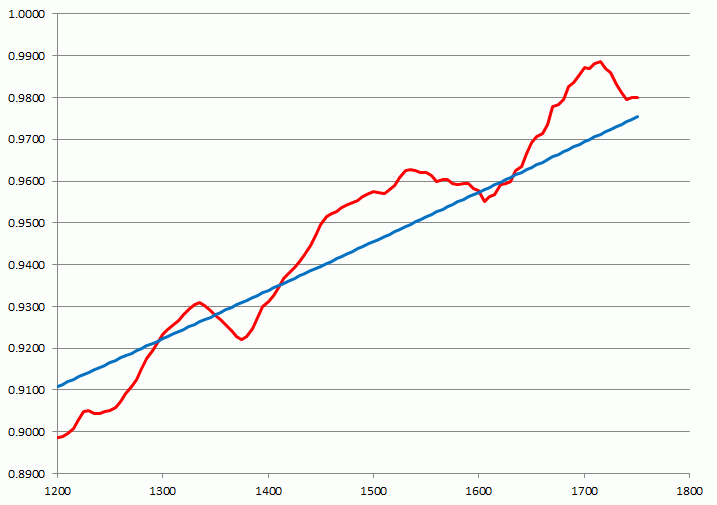When the half-life was corrected in , the year was taken as a base date from which to calculate all resulting dates. It is presumed that the proportion of atmospheric 14 C is the same today as it was in 10 , 11 and that the half-life remains the same. If a radioactivity level comes back as half of what would have been expected if the organism had died in , then it is presumed to be 5, years before This does not mean that we have a precise year of BC, it means we then need to calibrate through other methods that will show us how atmospheric concentrations of the 14 C isotope has changed - most typically through the dendrochronology records tree ring data Very old trees such as North American Bristlecone Pine are ideal for constructing long and accurate records of the state of the atmosphere.
This allows researchers to account for variation by comparing the known records of 14 C levels in the tree record, looking for a tree record that has the same proportion of radiocarbon. The overlapping nature of the tree records means this is the most accurate record we have.
Archaeology was one of the first, and remains the major, disciplines to use radiocarbon dating and this is why many enter into the lab through combining chemistry and archaeological studies. It has a greater impact on our understanding of the human past than in any other field. Radiocarbon dating is profoundly useful in archaeology, especially since the dawn of the even more accurate AMS method when more accurate dates could be obtained for smaller sample sizes. One good example is a critical piece of research into the diet of the fragile Viking colonies of Greenland 13 for example; the study examined not just the 14 C dates of the people in the graves, but was also in examining their diet through examining the carbon isotopes themselves.
The study concluded dates that were already suspected but not confirmed: There has been much debate about the age of The Shroud of Turin. It has become an important relic for many Catholics. The debate raged on for the decades after its discovery. Experts pointed to its medieval design, depiction of Christ and several other key factors marking it as in the region of years old.
It wasn't until , and several subsequent tests since then, that this was confirmed 14 ; it is now the best-known example of the success of the AMS method as countless tests have been carried out and confirmed the dates. A significant portion of the Shroud would have been destroyed using the older method. The paper for the study is available online Each subsequent test has come back with dates of the mid 14 th century.
Landscape Archaeology is a bridge between archaeology and environmental sciences though many consider it an environmental science in its own right. It is the study of how people in the past exploited and changed the environment around them. Typically, this will involve examining spores and pollen to examine when land was cleared of scrub and trees in the Neolithic Revolution to make way for crops. Through photosynthesis, plants absorb both forms from carbon dioxide in the atmosphere. When an organism dies, it contains a ratio of carbon 14 to carbon As the carbon 14 decays with no possibility of replenishment, the ratio decreases at a regular rate.
How Does Radiocarbon Dating Work? | www.mfarrow.com
This rate is known as half-life. The measurement of carbon 14 decay provides an indication of the age of any carbon-based material. Dates may be expressed as either uncalibrated or calibrated years. A raw date cannot be used directly as a calendar date, because the level of atmospheric carbon 14 has not been constant during the span of time that can be radiocarbon dated. In addition, there are substantial reservoirs of carbon in organic matter, the ocean, ocean sediments, and sedimentary rock.
Cite this article Pick a style below, and copy the text for your bibliography. Retrieved January 12, from Encyclopedia. Then, copy and paste the text into your bibliography or works cited list. Because each style has its own formatting nuances that evolve over time and not all information is available for every reference entry or article, Encyclopedia.
Radiocarbon dating
As a result of cosmic radiation a small number of atmospheric nitrogen nuclei are continuously being transformed by neutron bombardment into radioactive nuclei of carbon— Some of these radiocarbon atoms find their way into living trees and other plants in the form of carbon dioxide , as a result of photosynthesis. When the tree is cut down photosynthesis stops and the ratio of radiocarbon atoms to stable carbon atoms begins to fall as the radiocarbon decays.
The technique was developed by Willard F. Libby —80 and his coworkers in — This radio-isotope decays to form nitrogen, with a half-life of years. When a living organism dies, it ceases to take carbon dioxide into its body, so that the amount of C 14 it contains is fixed relative to its total weight.

Over the centuries, this quantity steadily diminishes. Refined chemical and physical analysis is used to determine the exact amount remaining, and from this the age of a specimen is deduced.
History of Radiocarbon-14 Dating
The ratio between them changes as radioactive carbon decays and is not replaced by exchange with the atmosphere. Print this article Print all entries for this topic Cite this article. Carbon dating Carbon dating is a technique used to determine the approximate age of once-living materials.
